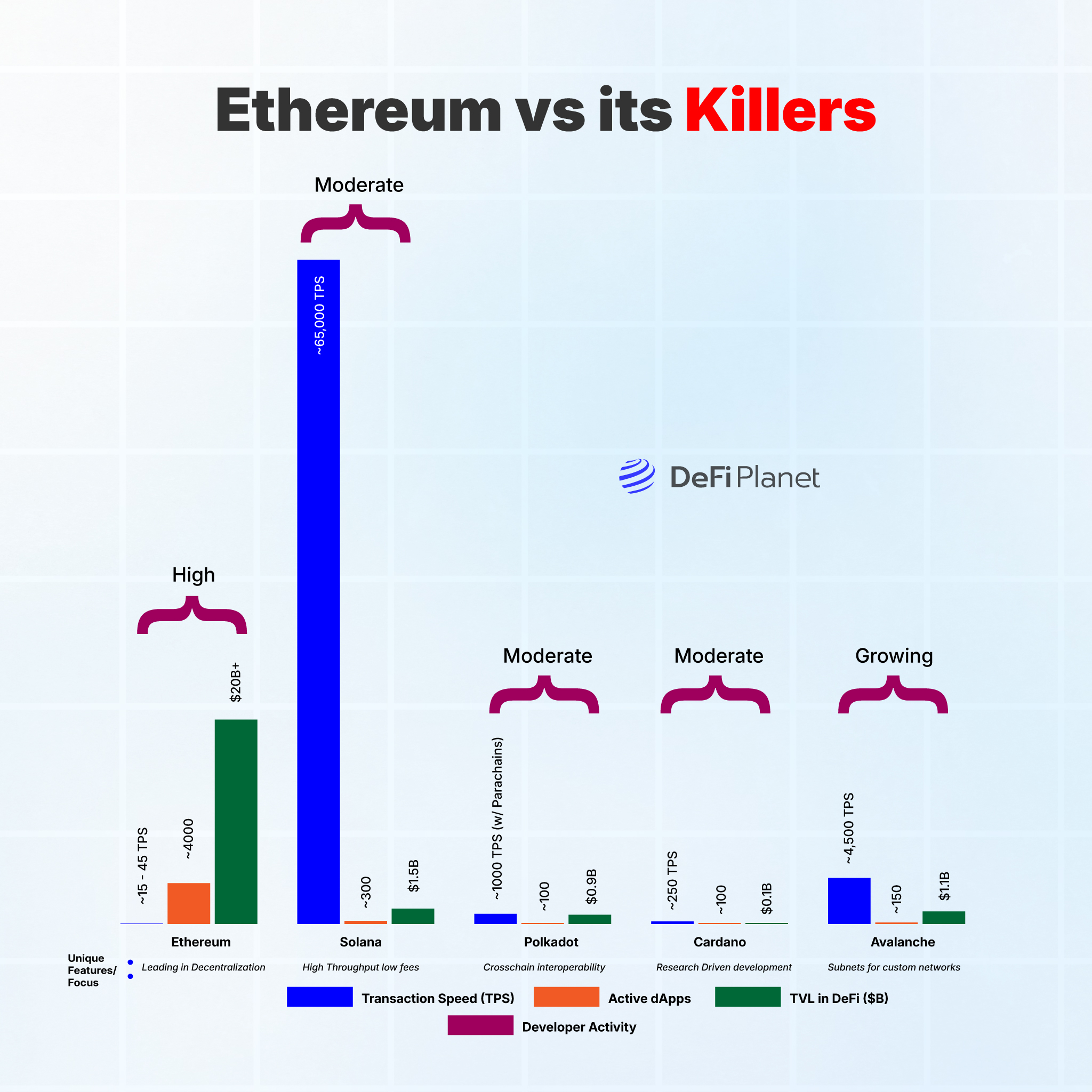Last updated on February 3rd, 2025 at 04:57 pm
At their debut, Solana, Polkadot, Avalanche, and a host of some blockchain networks were dubbed “Ethereum Killers”—they came bearing promises of faster transactions, lower fees, and innovative technology to dethrone Ethereum in the DeFi ecosystem.
While Ethereum had introduced a revolutionary concept with smart contracts, its growing pains led to a fertile ground for these new entrants to make bold claims and showcase their technological innovations.
But several years later, how have these contenders fared? Have they lived up to their potential, or has Ethereum maintained its dominance?
This article seeks to evaluate the current state of these Ethereum competitors, examining their development, adoption, and technological advancements over the years. While token prices frequently capture headlines, our focus here will be on the underlying technology and progress of these alternative blockchains.
The Rise of the Ethereum Killers: A Look Back
In the early days of blockchain technology, Ethereum was a groundbreaking platform, especially with its introduction of smart contracts and decentralized applications (dApps). However, as its popularity soared, so did its limitations, particularly its scalability issues, high transaction fees, and network congestion.
This led to the emergence of several rival blockchains, each promising to address Ethereum’s shortcomings and offer superior alternatives. Among them, Solana quickly gained attention. Launched in 2020, it aimed to overcome Ethereum’s scalability issues by implementing a consensus mechanism known as Proof of History (PoH), significantly improving transaction throughput. Solana’s developers claimed the platform could handle thousands of transactions per second (TPS) while maintaining low costs.
Ethereum’s competitors also included projects founded by its own creators. Gavin Wood and Charles Hoskinson, both co-founders of Ethereum alongside Vitalik Buterin, left the team to create their own visions of the ideal blockchain. Polkadot, Wood’s brainchild, sought to address Ethereum’s limitations through an innovative approach—a network of blockchains that could communicate seamlessly. Designed as a multi-chain framework, Polkadot enables different blockchains to interoperate and share information securely, enhancing scalability and flexibility while encouraging experimentation and innovation in blockchain technology.
Hoskinson’s efforts resulted in Cardano, a platform grounded in rigorous academic research and peer-reviewed protocols. Cardano promised enhanced scalability and security through its layered architecture, which separates the settlement and computation layers to improve transaction efficiency and overall performance. Its Ouroboros Proof of Stake (PoS) algorithm aimed to balance energy efficiency with robust security.
Ethereum vs its Killers

Binance Smart Chain (BSC) and Avalanche are also significant players in the Ethereum-killer narrative. Launched in 2020, BSC adopted a consensus mechanism called Proof of Staked Authority (PoSA), combining elements of Proof of Stake (PoS) and Proof of Authority (PoA). This hybrid model allowed for shorter block times and lower fees.
Avalanche, on the other hand, aimed to provide high throughput and low latency through its novel consensus protocol. By leveraging its unique subnet architecture, Avalanche sought to enable customized blockchain ecosystems while ensuring scalability and interoperability.
Are the Ethereum Killers Living Up to Expectations?
Ethereum’s limitations are well-documented: it is capable of handling 15-30 transactions per second (TPS), but its network congestion and variable gas fees, which can soar from a few dollars to over $100 during busy periods, remain pain points.
Yet, its dominance persists, supported by over 8,865 monthly active developers and a thriving DeFi ecosystem holding around $46.04 billion in Total Value Locked (TVL) as of mid-2024. According to current data, Ethereum supports more than 4,500 dApps; that’s over 10 times the next platform’s figure on the list.
Solana has made significant strides in terms of scalability and speed, boasting a throughput of 65,000 TPS and impressively low transaction fees ranging between $0.003 and $0.030.
Solana’s ecosystem hosts over 440 dApps, with a DeFi TVL of approximately $4.698 billion as of September 2024. Its developer base—comprising 2,500 to 3,000 monthly active developers, including 664 full-time—demonstrates consistent growth. However, reliability issues remain a concern due to its history of outages, which has dented confidence in its network stability.
Polkadot processes over 1,000 TPS with transaction fees averaging $0.60. As of September 2024, its ecosystem includes over 500 dApps and is supported by more than 2,400 monthly active developers, including 761 full-time contributors.
With a TVL of $460 million across its parachains, Polkadot’s vision of cross-chain interoperability is gradually materializing. However, its complex architecture has slowed adoption and presents challenges for developers and users alike.
Cardano, often characterized by its methodical and research-driven approach, theoretically supports up to 1 million TPS. In practice, its performance has yet to reach such heights. Its low transaction fees of $0.10, combined with a growing DeFi ecosystem boasting a TVL of $118.74 million and over 1,315 dApps, showcase its potential. However, development delays and a relatively small pool of 635 monthly active developers have limited its momentum.
BSC, processing up to 2,222 TPS with transaction fees ranging from $0.10 to $0.50, has maintained a strong presence in the DeFi space. As of January 2024, BSC supports over 4,700 dApps and holds a TVL of $4.4 billion. Despite its robust activity, BSC faces criticism for centralization, as its governance and network security are controlled by Binance’s limited number of validators. This centralization has raised concerns about the network’s resilience and decentralization ethos.
Avalanche aims to address Ethereum’s scalability issues with a throughput of 4,500 TPS and low transaction fees of $0.01. Its interoperability with Ethereum, enabled by the Avalanche Bridge, has attracted projects seeking cross-chain functionality.
Avalanche’s ecosystem includes over 195 dApps, with a TVL exceeding $912.26 million as of 2024. However, network congestion occasionally hampers its performance, causing delays and frustration for users. With approximately 1,706 monthly active developers, including 496 full-time contributors, Avalanche continues to grow but faces stiff competition.
While these blockchains bring unique innovations to the table—whether it’s Solana’s speed, Polkadot’s interoperability, Cardano’s research-driven ethos, Binance Smart Chain’s DeFi focus, or Avalanche’s scalability—none have yet managed to dethrone Ethereum. Challenges such as network reliability, complex architectures, and slower adoption continue to hinder their growth. Ethereum’s deep developer ecosystem, large TVL, and ongoing upgrades ensure its continued dominance in the blockchain space.
Can Ethereum Truly Be Killed?
The notion of Ethereum being dethroned has driven innovation in the blockchain space, but a closer look at its so-called “killers” reveals a more nuanced reality. While platforms like Solana, Polkadot, Avalanche, Binance Smart Chain, and Cardano have made strides, none have fully overtaken Ethereum in terms of adoption, developer activity, or ecosystem robustness. This is because Ethereum’s dominance lies not only in its first-mover advantage but in its network effects—its vast developer community, the largest DeFi and NFT ecosystems, and an unmatched level of trust.
Even with competitors touting faster transactions, lower fees, or novel architectures, Ethereum continues to evolve. Its transition to Ethereum 2.0, combined with Layer 2 solutions like Arbitrum and Optimism, directly addresses the limitations that spawned the “Ethereum killer” narrative in the first place.
While competitors like Solana have found niches—focusing on speed and accessibility—they remain complementary rather than wholly substitutive to Ethereum. Solana’s appeal for gaming and high-frequency applications highlights the blockchain space’s increasing specialization rather than its consolidation under a single platform.
Interestingly, Ethereum’s greatest challengers might come from within its ecosystem. Layer 2 solutions, designed to address Ethereum’s scalability and fee issues, could redefine the blockchain landscape. These solutions, including Optimistic Rollups and zk-Rollups, represent a transformative shift in how Ethereum operates. While a deep dive into Layer 2 solutions is the subject of another article, it’s worth noting that they enable Ethereum to remain competitive while empowering developers to innovate within its framework.
READ MORE: Are Layer 2 Solutions Enhancing Ethereum—or Killing it?
What Lies Ahead for Ethereum Killers?
We must acknowledge that these so-called “Ethereum killers” have enriched the ecosystem with diverse approaches, solving specific issues and carving out unique niches. However, their path forward is both challenging and promising.
Each network—whether it’s Solana, Polkadot, Cardano, Binance Smart Chain, or Avalanche—is finding its niche and advancing its technology. But to truly thrive, they must overcome the barriers that hinder widespread adoption, including reliability issues, complex architectures, and concerns over centralization.
The blockchain space is becoming increasingly collaborative, with different platforms serving specific needs rather than competing for absolute dominance. The true winners in this landscape are the users, who benefit from innovation, lower costs, and greater options as platforms specialize and mature.
Ultimately, the blockchain world is vast enough for multiple winners. Ethereum’s dominance may be challenged, but it’s unlikely to be outright “killed.” Instead, the industry is evolving toward an ecosystem where Ethereum stands as the cornerstone, surrounded by a constellation of complementary networks and Layer 2 solutions. The question is no longer whether Ethereum will be replaced but how these innovations will coexist in the blockchain ecosystem of tomorrow.
Disclaimer: This article is intended solely for informational purposes and should not be considered trading or investment advice. Nothing herein should be construed as financial, legal, or tax advice. Trading or investing in cryptocurrencies carries a considerable risk of financial loss. Always conduct due diligence.
If you would like to read more market analyses like this, visit DeFi Planet and follow us on Twitter, LinkedIn, Facebook, Instagram, and CoinMarketCap Community.
Take control of your crypto portfolio with MARKETS PRO, DeFi Planet’s suite of analytics tools.”






















